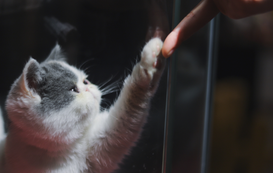- Home
- Cat Sitter Blog
- Cat Ownership
- How and Why You Need to Give Your Cat a Bath


Popular posts
How and Why You Need to Give Your Cat a Bath
Giving your cat a bath can be a daunting task. The fact is, most cats don’t like water, and they won’t hesitate to let you know it. If you’re not careful, bathing them could end up looking like a disaster area: a struggle back and forth, biting, scratching, and fleeing for safety. You could end up more drenched than your cat!
Thankfully, cat needs don’t always include baths. Cats are self-grooming creatures that spend several hours a day licking their fur. This might not sound hygienic to you, but it actually helps keep them clean and stress-free. There are some cases where your cat needs a bath, though; when that happens, it doesn’t have to be a terrifying experience for either of you.
Before You Bathe Your Cat
Bathing your cat is not an activity you need to subject them to under normal circumstances; however, there are some cases where your cat’s tongue can’t get the job done. Here are a some of examples when bathing your cat is necessary:
- Your cat gets something particularly dirty on their coat
- You have a long-haired cat that needs extra grooming maintenance
- You have a cat breed that requires help grooming
- Your cat has fleas, ticks, lice, or other pests
- Your cat has a skin condition
- Your cat is elderly, obese, or arthritic
If any of these situations apply, you will need to learn how to incorporate regular bathing into your cat’s schedule. Fortunately, you’ve come to the right place! Follow the methods below to ensure your cat’s bath is as safe and comfortable as possible for you and them.
Prepare
It’s important to make sure you’re fully prepared before you start bathing your cat. Unless you have the rare cat who likes hanging out in water, you’ll want to make sure everything is in place ahead of time, so you can give your nervous kitty your full attention.
Before bathing cats, consider trimming the tips of their claws for added protection against scratches. Furthermore, if you can, avoid giving your furball a bath when they’re acting particularly spunky. It will save you a lot of hassle to bathe them when they’re relaxed or sleepy.
Gather Supplies
Here are the supplies you’ll need ready on hand before you give your cat a bath:
- Gloves: Gloves will keep you clean and help protect you against scratches and/or bites—just make sure they’re long enough.
- Cat shampoo: Special cat shampoo is a must. It’s important that you don’t use human shampoo because it would dry out their skin. Depending on the circumstance, it might be a good idea to get a recommendation from your vet on which one to buy. You can find shampoo for cats at any pet store or online.
- A washcloth: This is only needed if their face needs to be cleaned too.
- A bucket or pitcher of water: Using a pitcher or bucket is necessary to avoid putting your cat near running water, which may cause extra anxiety for them. Depending on how large your cat is, fill a large bucket or 1-2 pitchers with lukewarm water. It’s important to make sure the water is a comfortable temperature.
- A rubber mat: Place a rubber mat in your bathtub or sink pre-bath, so your cat doesn’t slip.
- Towels: Make sure to have a large towel ready, so you can dry off your cat post-bath. If you don’t have a rubber mat, you can put a towel at the base of your sink or bathtub as an alternative method to keep your cat from slipping.
- Treats: After the bath, reward and comfort your stressed kitty with treats. This way, they’ll be less likely to throw you dirty looks in the coming days.
How to Bathe a Cat: Step-by-Step Tips
Once you’re ready, it’s bath time! Don’t stress: as long as you have your supplies ready and are gentle with your cat, you can pull this off. Follow below for a step-by-step guide to make sure bath time goes smoothly for you and your feline friend.
Steps for Cat Bath Time:
- With your gloves on and filled bucket or pitcher(s) ready, place your cat into a large sink or bathtub. Let your cat get acquainted with a few inches of warm water. This will help them understand it won’t hurt them. Allow them to sniff the area and investigate your water pitcher(s). Put some water on your fingers and let them sniff it, then place your wet hands lightly on your cat’s hair. Repeat the process a few times.
- Once your cat has been introduced to the water, hold them carefully and begin scooping water over your cat’s body from the neck down. Be sure to avoid their head for now. Avoid using the shower head sprayer if you have one—at least for their first bath.
- When they’re sufficiently wet, massage and lather the special cat shampoo into their fur.
- Pour the remainder of the pitcher(s) over their fur from your cat’s neck down, making sure to rinse out all the shampoo.
- Now, dampen your washcloth and carefully wipe their cheeks and forehead, avoiding their eyes and ears. You don’t need to use (diluted) shampoo unless their face is particularly dirty.
- Towel-dry as much water off your cat as you can, and then let them air-dry in a warm room so they don’t get too chilly.
- Give your cat a lot of love and treats to reward them for a successful bath.
It’s likely that most cats will never view the bath experience as a particularly fun time, but these tips will greatly reduce bath-related stress. Keep in mind, some cats might still find the experience too distressing. Be very gentle during the bathing process and stay attuned to how your cat is handling it.
Other Ways to Clean Your Cat
There’s more than one way to groom a cat. If bath time is still too much for your furbaby, try these alternate cat bathing methods instead:
- Go to a groomer: Do your research and find a professional groomer that specializes in cats. In some cities, you can hire a mobile grooming service to come right to your house.
- Use cat cleaning wipes: If your cat isn’t too dirty and doesn’t have bugs, you can use cat cleaning wipes to take the “scary” water out of bathing. A cat’s skin is sensitive, so choose pet wipes that are safe for both cats and dogs, or use cat-specific brands.
Cat Grooming Tips
Aside from baths, there are many other ways to keep your cat’s fur, skin, and face clean and bright.
- Ear wipes: Use pet ear wipes to remove any wax or dirt from your cat’s ears.
- Brush regularly: Get a de-shedding comb or brush to remove excess fur caught in your cat’s coat. This will help prevent hairballs and also make your cat soft and clean for snuggles.
- Face wipes: Use pet wipes to clean your cat’s face folds and to remove any gunk from the corners of their eyes. Don’t get too close to your cat’s eyes with a wipe—wait for the gunk to move a little further down their face before cleaning.
- Trim nails: Cat claws can grow long enough that they become uncomfortable for your cat to walk on, even with a scratching post. Regular trims ensure healthy, normal growth while also reducing any potential injury or infection in your cat’s nails.
Now that your cat is clean and healthy, they’re ready for your next guests to come and play, whether having the neighbors for dinner or introducing a new cat sitter for your vacation. If you’re looking for an expert sitter check out our fully insured and vetted Meowtel cat sitters.




































































